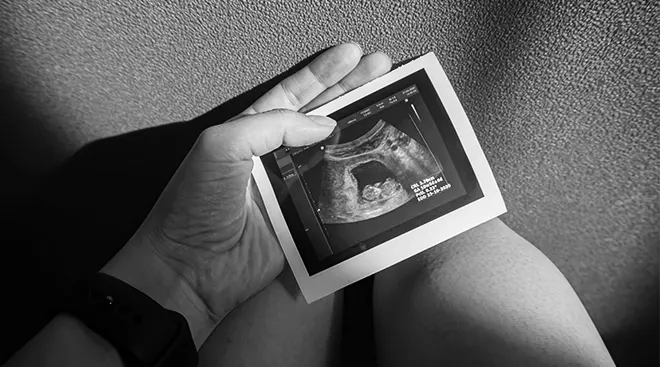What Is a Threatened Miscarriage?
Experiencing bleeding during pregnancy can be terrifying, but it’s also somewhat common. According to the American College of Obstetricians and Gynecologists (ACOG), up to 25 percent of women experience bleeding in the first trimesterfor a range of reasons. Unfortunately bleeding is also one of the symptoms that can suggest the possibility of a miscarriage. Your provider may refer to this as a threatened miscarriage.
That’s a big term to absorb during pregnancy, so it’s understandable to have questions and fears. Just know this: Having a threatened miscarriage doesn’t mean that you’ll definitely miscarry. Here’s what the term actually means, and next steps to know about.
A threatened miscarriage, which is also called a threatened abortion, is a term that often comes up when someone experiences bleeding in pregnancy. A threatened miscarriage occurs when a pregnant woman or expectant person has vaginal bleeding, but a closed cervix and the presence of a fetal heartbeat, explains Lisa N. Jackson, MD, assistant clinical professor in the Raquel and Jaime Gilinski Department of Obstetrics, Gynecology and Reproductive Science at Mount Sinai and a partner at Uptown OBGYN of New York.
Again, a threatened abortion doesn’t mean that you’ve had a miscarriage or that you will miscarry; it’s simply a term that medical providers use to describe a constellation of symptoms.
The bleeding occurs when there’s a disruption of the vessels between the uterus and where the placenta—the temporary organ that connects you to your developing baby via the umbilical cord—implants, Jackson explains. “Sometimes a collection of blood can be seen on ultrasound, and this is called a subchorionic hematoma,” she says.
You can also have a threatened miscarriage due to small falls, injuries or stress during the first trimester, according to Mount Sinai. Or, it can simply just happen with no known cause, adds Jennifer Wider, MD, a women’s health expert and ob-gyn.
Experts can’t identify any threatened miscarriage risk factors. “We’re not sure why this happens in some pregnancies but not in others,” Jackson says. “The good news is that the majority of the time, bleeding in early pregnancy with the presence of fetal heart tones and a closed cervix doesn’t result in miscarriage.”
Symptoms can vary by pregnancy, but bleeding is the big one. According to Wider, threatened miscarriage symptoms generally include:
- Light bleeding, with or without small clots
- Mild cramps or abdominal pain
How long does a threatened miscarriage last? These symptoms can persist for a couple of days to a week or more.
If your healthcare provider suspects a threatened miscarriage, they’ll usually do an ultrasound to see inside your uterus, along with a blood test to test pregnancy hormones and make sure the pregnancy is still viable, Wider says. Your provider may also do a pelvic exam to make sure that your cervix is still closed, she adds.
Healthcare providers may not do anything for a threatened miscarriage. However, if you’re considered high risk for miscarriage, they may recommend progesterone supplementation. Studies have found that vaginal progesterone supplementation may be beneficial for those at risk of loss, especially if they have a history of miscarriage.
Your doctor or midwife may also recommend that you avoid or restrict some activities, including sex at least until the bleeding stops, Wider says.
If you’re facing a threatened miscarriage, it’s important to stay calm and talk to your healthcare provider. “Luckily, the majority of threatened miscarriages don’t result in pregnancy loss,” Jackson says. Wider agrees: “For most women, the outlook is good, and they go on to have normal pregnancies.”
That doesn’t mean this isn’t an intense experience to go through though. “Bleeding in early pregnancy can be very stressful,” Jackson says. “Meeting with your ob-gyn and being evaluated will help deal with the stress.” A follow-up ultrasound may also be scheduled to offer some reassurance.
For the time being, you’ll want to get plenty of rest and support from loved ones, Wider says. Rather than trying to toughen it out alone, lean on your people for help and emotional support.
Miscarriage can be devastating, and it’s understandable to want to do everything you can to lower your risk. But often there’s not anything you can do to prevent it. “Miscarriage is a common event that women have very little control over,” Jackson says. Per ACOG, half of miscarriages happen when the embryo doesn’t develop properly.
While you can do your best to avoid certain risk factors, like alcohol and smoking, ACOG stresses that working, exercising, stress, having sex or having used birth control pills before getting pregnant do not cause miscarriage.
“It’s important that women not blame themselves or their actions for these events,” Jackson says.
Please note: The Bump and the materials and information it contains are not intended to, and do not constitute, medical or other health advice or diagnosis and should not be used as such. You should always consult with a qualified physician or health professional about your specific circumstances.
Lisa N. Jackson, MD, FACOG, is an ob-gyn with over 15 years of experience and a partner at Uptown OBGYN of New York. She earned her medical degree from Vanderbilt University School of Medicine in Nashville, Tennessee and completed her residency in Chicago at Rush University Medical Center. She also serves as an assistant clinical professor of ob-gyn at the Mount Sinai Hospital in New York City.
Jennifer Wider, MD, is a women’s health expert and author of The New Mom’s Survival Guide. She received her medical degree from the Mount Sinai School of Medicine in New York City.
American College of Obstetricians and Gynecologists, Bleeding During Pregnancy, August 2022
Mount Sinai, Miscarriage - Threatened, November 2022
StatPearls, Threatened Miscarriage, February 2024
American College of Obstetricians and Gynecologists, Early Pregnancy Loss, September 2024
Learn how we ensure the accuracy of our content through our editorial and medical review process.
Navigate forward to interact with the calendar and select a date. Press the question mark key to get the keyboard shortcuts for changing dates.



















































